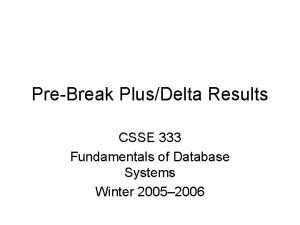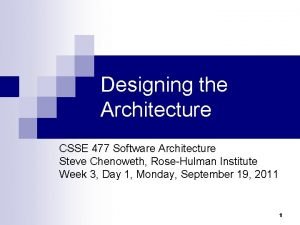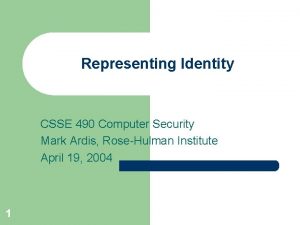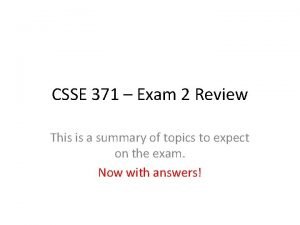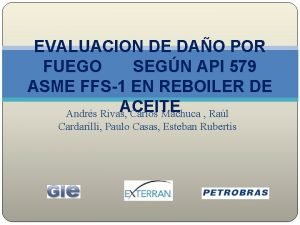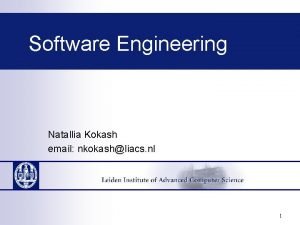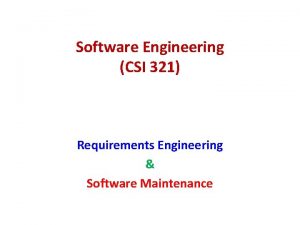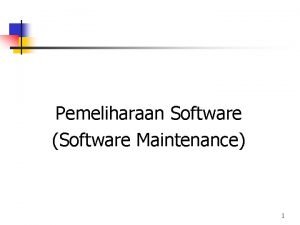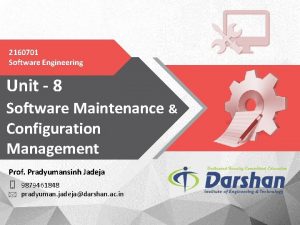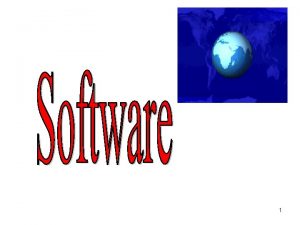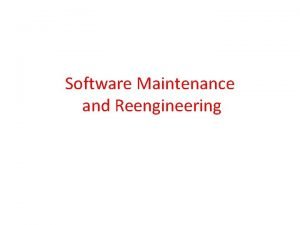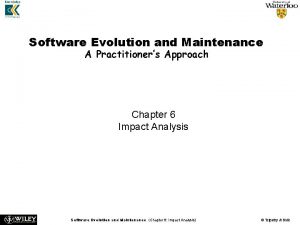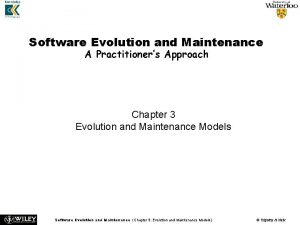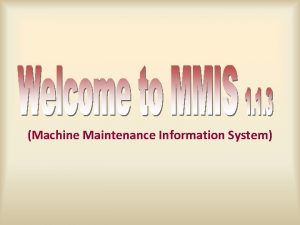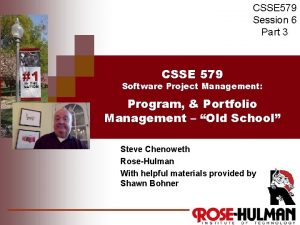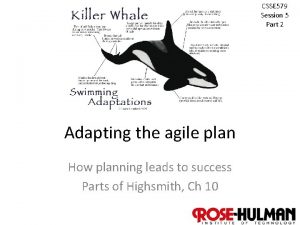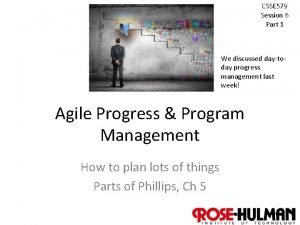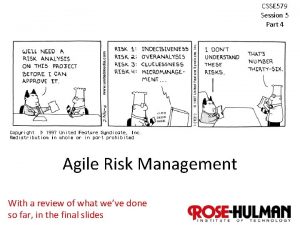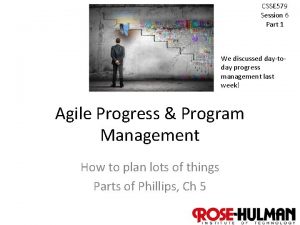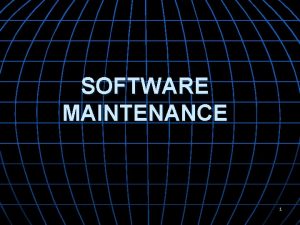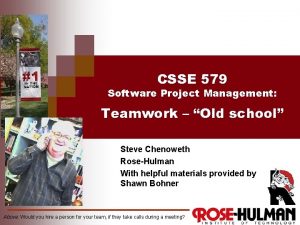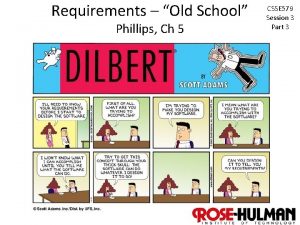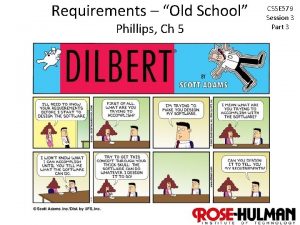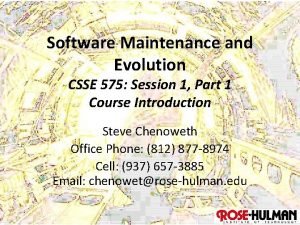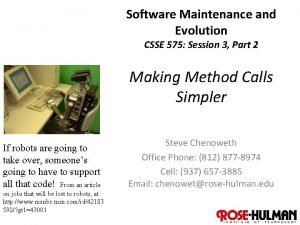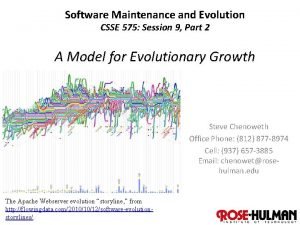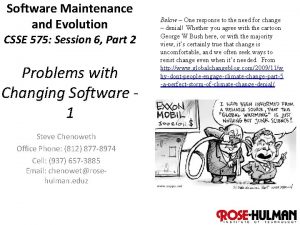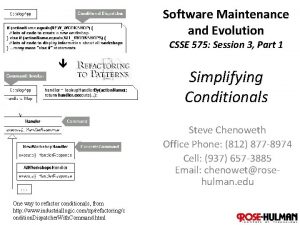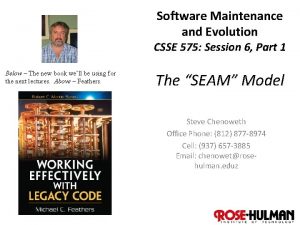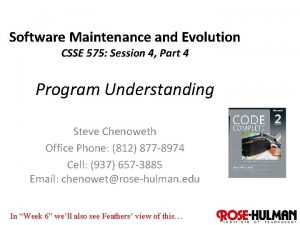CSSE 579 Session 9 Part 1 Software Maintenance






















- Slides: 22

CSSE 579: Session 9, Part 1 Software Maintenance and Project Management Steve Chenoweth Office Phone: (812) 877 -8974 Cell: (937) 657 -3885 Email: chenowet@rose-hulman. edu Above – Software is not the only place where users are sensitive to the quality of maintenance. How about those Indiana roads? From http: //www. city. westlafayette. in. us/department/division. php? f. DD=10 -62. 1

This week • This week’s new topics – – – Maintenance and Project Management – this slide set Metrics and measurement, including EVM – the second slide set Critical Chain – the third slide set Agile Release Management and Risk Management – the fourth slide set • The usual questions, this time on teamwork in your world. • Next week’s (Week 10) topics – “Ethics and Trends” – Advanced topics & new trends – including technical debt (reading this week) – Planning for continuous integration and automation – Ethical decision making • Third exam is already out on the web site! Due Monday, May 25 (hard deadline). 2

This slide set Maintenance and project management! – • What’s different about maintenance? • What are the goals, from a PM perspective? • What are the organizational options? • The article you read – Case study: What are the critical issues and success factors of maintenance? • What does Donald Reifer have to add? 3

What are “Maintenance” topics? • Maintenance is a subset of “evolution” • Emphasizes what has to be changed – – As time goes on after initial development – Especially from the developer’s perspective • And issues with that A practitioner’s view – And approaches to resolving those • Lots about bug fixes and minor enhancements • Evolution as a whole, in contrast – • Studies how things are done generally – Like different approaches in different vocational areas, and – The overall “laws of evolution” in effect – E. g. , studies of system decay over time A manager’s / theoretician’s view • Lots about adaptation and migration, which is useful for activities like planning product strategies and major releases. 4

General Maintenance Themes • Need to be self-aware while doing it • Need to be systematic • Need to document – E. g. , How long did it take to make that fix? • Experiment – try alternative approaches – What should we try next time? • Tune and retune based on what’s learned – Amount of tuning is based on maturity with product, processes and tools 5

Goal = high “maintainability” • Best practices are learned in each of the areas pictured. – In source code, for example, it involves things like: • Localizing changes • Preventing ripple effects • Deferring binding time • We’ll discuss how to achieve this, in next slide set. 6

Setting up maintenance processes • Done as part of product planning – Not at end of initial development – Maintenance is not a “post-delivery activity” • Need a “Maintenance plan” – Includes a “transition plan” to maintenance group (or mixed activities by a single group) – Need to decide who does maintenance – see next two slides – Transition to maintenance is painful, no matter how it’s done 7

Hey boss, we finally shipped, so we’re ready to dive right into Release 2! Software start-up horror story Who are you kidding? The customer just called…You can’t do anything else till you fix all those new bugs! The payoff for two years of 80 -hour weeks… 8

Same team does maintenance? • Advantages: – Transition plan is simpler – • No personnel changes Developer has the best knowledge Don’t need formal communication to maintainers Separate maintenance organization has its own priorities No need to decide “who goes where” at end of initial development – Less need for training /expertise transfer – Residual developers would still need to help separate maintainers – Already know product tools – – 9

Different team does maintenance? • Advantages: – Maintenance group tends to do better processes – Not distracted by upcoming major releases or new products • Developers can do these (usually) – Understand metrics for maintenance 10

Maintenance Issues 11

Conceptual issues • Maintenance relies on all prior work. • Documentation and the system get more complex. • Difficult to track changes. • Ripple effects. • Personnel / knowledge loss over time. 12

The case history you read • Sneed & Brossler, “Critical Success Factors in Software Maintenance: A Case Study, ” 2003 • Goal – – Apply known 8 factors to a large project – Evaluate in importance for current project • “Success” traditionally == – Increase in user satisfaction – Reductions in costs Harry M. Sneed, 2003 13

Case history, cntd • Authors proposed instead, Success is in terms of: – – – – Functionality Quality Complexity Volatility Costs Release deadlines User satisfaction Profitability A volatile couch, in action. 14

The authors’ advice: • • Preserve functionality. Preserve quality. Don’t increase complexity. Don’t make the product volatile. Don’t increase costs. Keep deadlines. Maintain user satisfaction. Don’t lose money. 15

Case history, cntd • Authors then measured each of these 8 factors, for the target system: – They saw success on the first six – The last two – inconclusive • Partly, the system was now technologically outdated • The target system was a securities-trading banking system. – Needed to become web based! 16

Donald Reifer’s Perspective • From his 2012 book, Software Maintenance Success Recipes. CRC Press, ISBN 978 -1 -4398 -5166 -1. • Maintenance is not a tack-on to development. • Development is the start of maintenance. 17

Realities… Conclusion… • Our current perceptions don’t match the actualities of maintenance 18

What’s important? What do you think of first, when you think of software maintenance activity? 19

What influences maintenance actions? • Depends… • But it differs from development! 20

What else is in Reifer’s book? 21

Or… 22
 Csse results
Csse results Software architecture cartoon
Software architecture cartoon Csse certification
Csse certification Csse exam
Csse exam Usaid ads 579
Usaid ads 579 Api 579
Api 579 Software maintenance in software engineering ppt
Software maintenance in software engineering ppt Alabama boating study guide
Alabama boating study guide Adaptive maintenance in software engineering
Adaptive maintenance in software engineering Software maintenance cost factors
Software maintenance cost factors Contoh software maintenance
Contoh software maintenance Adaptive maintenance in software engineering
Adaptive maintenance in software engineering How many phases are there in taute maintenance model?
How many phases are there in taute maintenance model? Maintenance and reengineering
Maintenance and reengineering Ripple effect in software maintenance
Ripple effect in software maintenance Software maintenance process
Software maintenance process Machine maintenance report
Machine maintenance report Part whole model subtraction
Part whole model subtraction Part to part ratio definition
Part to part ratio definition Part part whole
Part part whole What is technical description
What is technical description What is front bar
What is front bar The phase of the moon you see depends on ______.
The phase of the moon you see depends on ______.
